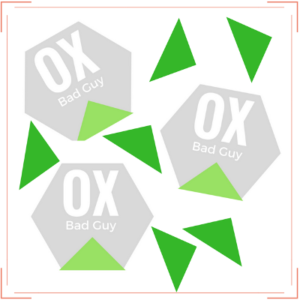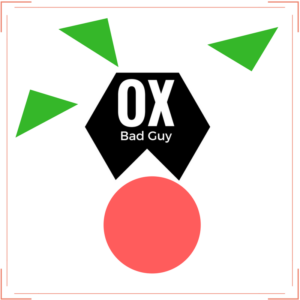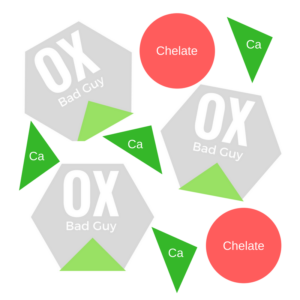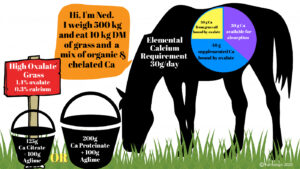Horses grazing high oxalate pasture can become calcium deficient, even when they eat their daily recommended intake of calcium. Click here for help identifying high oxalate grass species commonly found in horse pastures.
Horses grazing high oxalate pastures must be supplemented with a supply of calcium greater than their oxalate intake (Figure 1) or calcium in a form that cannot be bound by oxalates (Figure 2).

Figure 1 The darker green triangles represent inorganic calcium available for absorption from the gut into the bloodstream. The lighter green calcium has been bound by oxalates and is no longer bioavailable.

Figure 2. The red circle represents a calcium chelate which cannot be bound by oxalates and is available for absorption from the gut into the bloodstream.

Figure 3. Many oxalate countering supplements contain a blend of inorganic and chelated calcium to create an affordable and biologically effective solution for horse owners.
Supplementing horses on high oxalate pastures
A 500 kg horse in light work needs to consume 30 g of elemental calcium per day. A portion of this calcium requirement will be naturally contained in the roughage and hard feeds the horse consumes. Supplementary calcium is usually needed to balance any diet and horses grazing high oxalate pasture have an even higher requirement.
What is Chelated calcium?
Chelation is the process of binding minerals to an organic acid or an amino acid. If the form of calcium chelate (pronounced key-late) supplemented can be absorbed into the bloodstream, the calcium is ‘safe’ from binding to oxalates in the gut.
Because chelated minerals contain a molecule of carbon, they are also known as organic minerals. This is a definition from chemistry and does not mean ‘organic’ in the sense of being natural and chemical-free.
There are many forms of calcium chelates, some more bioavailable than others. For example, Highfill (2005) found that a calcium amino acid proteinate was not absorbed any more efficiently than inorganic calcium carbonate.
Is chelated calcium the only kind that prevents bighead?
No. You DO NOT have to supplement with chelated calcium BUT you do need to feed ADEQUATE calcium. Some dietary inorganic calcium is necessary to bind all oxalates present in the gut to prevent soluble oxalates crossing the gut wall and entering the bloodstream.
“To say that inorganic calcium cannot prevent bighead is akin to declaring paracetamol useless for pain management after using it at one-quarter of the recommended dose rate.”
Scientists have known for decades that feeding supplementary inorganic sources of calcium and phosphorous (such as lime or DCP) successfully controls bighead in horses grazing high oxalate pastures.
How much calcium does a horse on high oxalate pasture need?
The amount of actual supplement required to provide 30 g of calcium depends on the percentage of actual calcium in a calcium salt or chelate.

Figure 4. A 500 kg horse eating 10 kg dry matter of high oxalate pasture containing 1.4% oxalates and only 0.3% calcium will consume 30 g of calcium from the pasture and enough oxalate to bind 70 g of calcium. Unless the horse is supplemented with calcium, it will be mining 40 g of calcium from bone to maintain blood calcium levels.

Figure 5. To correct this balance with an inorganic calcium source, the horse needs 40 g of calcium (to ‘feed’ the oxalates) plus 30 g of elemental calcium (to meet the horse’s RDI). He needs less Aglime than DCP because lime has a higher percentage of calcium. If ‘Ned’ has a larger hard feed or eats some low oxalate pasture/hay, he will consume less oxalates and need less supplemental calcium to balance the diet.

Figure 6. An alternative is to correct the balance with a bioavailable chelate. The supplement only needs to provide 30 g of elemental calcium but should also add at least 40 g of inorganic calcium to bind soluble oxalates and prevent oxalate absorption into the bloodstream. It is also critical to ensure adequate phosphorous and magnesium are provided to balance mineral ratios for optimal uptake.
If you’re thinking, “Wow, that’s a lot of powder to feed a horse!” remember that these supplements are quite dense and heavy. For example, one metric cup (25o ml capacity) holds 330g of ag lime and the scoop from a pack of EVM TropiCAL holds 100g of ag lime.
In many cases, a horse will be eating a hard feed and some low oxalate grass or hay which significantly reduces the amount of calcium supplementation required. A diet analysis conducted by a qualified nutritionist experienced in balancing high oxalate diets is highly recommended for all horses grazing oxalate pastures.
A daily hard feed to mix the calcium supplement into is required to ensure each horse consumes enough supplementary calcium to prevent bighead. There is no scientific evidence that horses innately ‘know’ how much calcium they need.
Australian research has confirmed that equine diets must have a total calcium to oxalate ratio of 1:2 to prevent bighead.
Optimal absorption only occurs when co-dependant mineral levels are balanced relative to each other. It is of vital importance that calcium levels are balanced with the phosphorous and magnesium levels of the total intake. High oxalate pastures, like horse pastures all around the world, also need trace mineral supplementation (especially copper, zinc, iodine and often selenium) to balance critical mineral ratios across the whole diet.
Farmalogic’s team of university qualified equine nutritionists offer a free diet analysis service to fine-tune your horse’s diet and calculate the level of supplementation your horse requires.
Can bighead be cured?
In many cases, the answer is yes. Even when remodelled bone does not completely reshape, the structural weaknesses and secondary symptoms can be resolved with dietary changes and appropriate mineral supplementation.
Veterinarians treating horses with NSH have reported benefits from legume forages such as lucerne as well as supplemental inorganic calcium to establish a whole of diet calcium to phosphorous ratio of at least 4 to 1 for a period of 6 to 12 months.

Figure 7. Recovery from bighead – this pony’s diet of rhodes grass and lucerne hay was supplemented with EVM TropiCAL and Aglime.
What other management practices help?
In addition to feeding extra calcium as part of a balanced diet, there are some very effective management strategies to reduce the impact of high oxalate pastures and decrease the amount of calcium supplementation required.
- Reduce the oxalate intake of the diet by replacing some of the pasture intake with low oxalate forages such as lucerne (which has the added bonus of supplying 10g of elemental calcium per kg of hay) and grass hay made from low oxalate species.
- Create a physical space between calcium supplements and oxalates. Calcium uptake can be increased by removing the horse from high oxalate roughage and feeding low oxalate hay for half an hour before and after feeding the calcium supplement. This allows the body time to absorb the calcium while fewer oxalates are present in the gut.
- Pasture management to reduce high oxalate species. Strategic spraying, slashing and grazing management can be used to limit the proportions of high oxalate grass in a paddock. But remember that high oxalate grasses have some benefits, too. They’re often tough, drought resistant and survive under heavy grazing pressure where other grasses die off. They can provide green pick, omega-3 oils and ground cover at times of the year when low oxalate grasses and legumes have not survived.
With an understanding of what oxalates do, it is not difficult to supplement horses grazing high oxalate grasses to avoid ‘bighead disease.’ Farmalogic Equine offer free diet analysis service to help horse owners identify pastures and calculate their supplementation requirements. Contact us via diets@farmalogicglobal.com.





I recently purchased a property in Nabiac, NSW and am now learning about high oxalate grass for the first time. I have a 300 kg pony
and 3 x200kg donkeys, how much supplement should I mix in with their lucerne chaff? Please advise me as I am feeling out of my depth. They have been on these pastures for 5 months now. They get only 3 scoops of the chaff daily, do they need more supplement to catch up. They have a bighead mineral lick.
Hi Katherine, congratulations on your purchase! It’s great that you’re putting the effort into learning about oxalates and your horse’s modified calcium requirements. Our team of expert equine nutritionists can help you make sure your horses get everything they need. Please take advantage of our free diet analysis service at https://au.farmalogicglobal.com/free-horse-diet-analysis/ and our team will write you a customised diet plan for your horse.